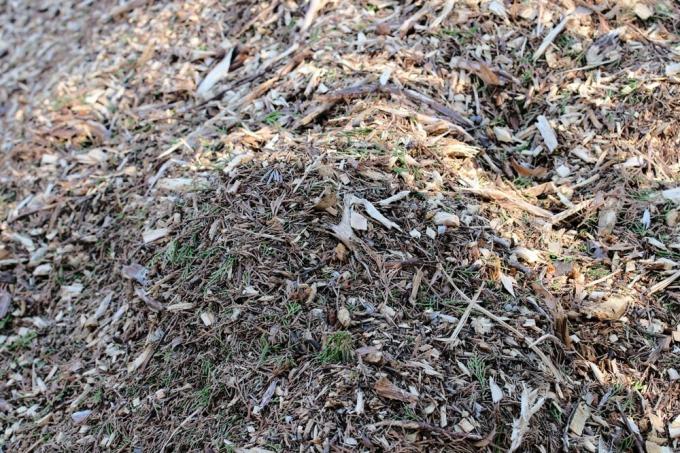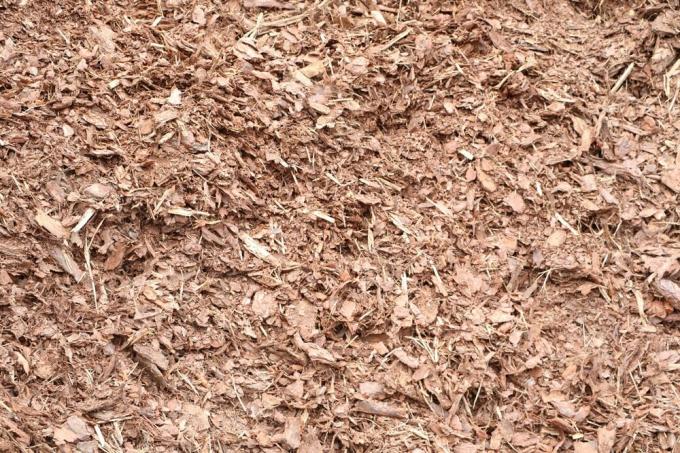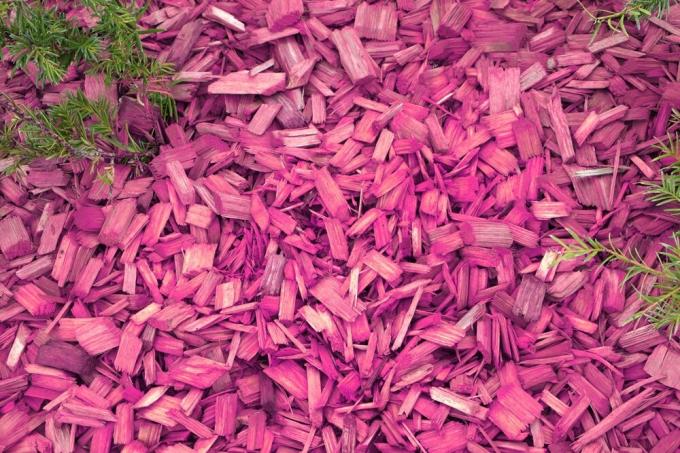

Table of contents
- Bark mulch properties
- weeds and bark mulch
- Use in the bed
- paths and larger areas
- shrubs
- trees
- Other mulching material
A layer of mulch in the garden has many benefits, regardless of where exactly it is applied. Mulch can protect paths from weeds, keep soil loose in beds, and add nutrients to trees or shrubs over time. Soil erosion is also successfully reduced with a mulch layer. However, bark mulch is particularly important for weed control.
Bark mulch properties
Mulch made from the bark of coniferous trees comes from waste from the timber industry. The bark pieces are crushed and sieved. They are available on the market in packs of different grain sizes, which are suitable for different purposes. A large grain size is suitable for large areas, smaller pieces of bark are suitable for small areas, especially between plants. Small bark mulch is preferred in the bed, as this releases nutrients during the rotting process.
A notice:
As the rotting process begins, nitrogen is consumed. If bark mulch is used in the vegetable patch, nitrogen fertilization should be carried out promptly.
Rapid decomposition of the bark mulch is undesirable on paths or large areas. There larger pieces are used or wood, which is more durable.
weeds and bark mulch
Many seed weeds are light germinators. A layer of mulch made from pieces of bark ensures that less or no light can penetrate to the ground. This prevents seeds from germinating. Even dark germs cannot grow very well without light and are easy to pull out due to the loose structure of the mulch. In addition to darkening, bark mulch also inhibits the growth of weeds due to the tannins it contains.
A notice:
However, these tannins can also prevent other plants from growing. The use of certain types of mulch can be useful for certain plants, such as rose mulch.
Use in the bed

Regardless of whether bark mulch is to be used on vegetables, strawberries or flowers, it must always be remembered that the mulch acidifies the soil and thus shifts the pH value. Some plants like this, such as blueberries, but others prefer a neutral soil. The requirements of the plants on the bed must therefore be clarified beforehand. The bark mulch is then used as follows:
- Rake the bed between the plants
- The soil is loosened up
- remove existing weeds together with the roots
- Distribute bark mulch with low grain thickness generously between the plants
- A layer thickness of 5 – 10 cm is aimed for
- simultaneous administration of nitrogen fertilizers
- Top up the mulch layer regularly
You can start with a thin layer of mulch, if weeds grow through, the layer can be thickened at any time. The bed no longer has to be raked afterwards, otherwise the bark mulch would be introduced into the soil and there would no longer be any protection against weeds. It is watered directly on the plants or on the mulch. Positive properties of the mulch layer:
- Protection from weeds
- reduced evaporation, less watering required
- after initial fertilization, nutrient supply over a longer period
- Soil remains loosened
- Soil creatures are protected from external influences
paths and larger areas
If paths in the garden are not paved and not overgrown with grass, they should often be kept free of weeds. Bark mulch is also good for this. It also doesn't matter that the pH of the soil can drop. The same applies to larger, free areas in the garden. In addition to the coarse-grained bark mulch, a weed fleece is also necessary.
- Cut the weed fleece to the required size
- Clear paths or squares of weeds
- level surfaces
- Lay weed control
- Apply bark mulch in a layer that is not too thick
Too much bark mulch is unnecessary here, since the weed fleece already curbs the growth of the plants. The mulch is just extra protection and more decorative than the fleece.
shrubs

Especially freshly planted shrubs like a layer of mulch around the root area. This prevents drying out and prevents the weed from growing as a competitor to the shrub. In addition, the soil area is continuously fertilized over a longer period of time. Plants that prefer acidic soil particularly benefit from bark mulch. These include blueberry bushes or rhododendrons. Bark mulch can be spread on the ground when planting a shrub or later.
- Plant a shrub or bush according to the instructions
- Remove weeds from the roots of old shrubs
- Loosen the soil, take special care with shallow roots
- Spread bark mulch over the clean root area
- choose medium to large grit
- Apply a layer about 10 cm thick
- Replace bark mulch depending on the speed of the decomposition process
trees
The tree pit of young trees, especially fruit trees, should be kept free of any vegetation. Older trees, on the other hand, are happy about a growth of soil-improving plants. Bark mulch, together with weed fleece, is ideal for keeping tree grates free. A tree roots in roughly the same area where its crown grows. The tree disc thus corresponds to the crown diameter. As with shrubs, it is also important for trees to find out about the soil requirements beforehand. Not all trees tolerate acidic soil, it may be necessary to use other mulch instead of bark mulch.
- Plant the tree according to the instructions, don't forget the support
- Cut the weed fleece to fit the size of the tree disc
- The root area can also be made larger
- remove more soil accordingly when planting
- Cut the weed fleece down to the middle
- Cut holes for tree and support
- lay on the ground around the tree and the support stick
- Cover the weed fleece generously with bark mulch
- coarse grit in a thin layer is sufficient
The young tree can be watered through the fleece and mulch without any problems. The situation is different with fertilizing, especially if coarse fertilizer such as compost or rotted manure is to be used. To do this, the mulch and fleece must be removed. Then the fertilizer is superficially worked into the soil. Then fleece and bark mulch are applied again.
Other mulching material

In addition to the classic bark mulch made from coniferous wood, there are also other materials that are suitable for mulching. Wood chippings are cheaper and acidify the soil less. Pine mulch is particularly decorative and durable. In the garden there are almost always green waste and remains of weeds. Tree or shrub cuttings are also suitable for mulching if they come from healthy plants and are chopped up.
 garden editorial
garden editorial I write about everything that interests me in my garden.
Learn more about mulch & bark mulch

Where can I get bark mulch for free? | 20 cheap sources of supply
Bark mulch for free is within reach if important sources of information are known. It is thanks to the Internet that generous donors of free bark mulch can be found with little effort. If the search comes to nothing, it is worth taking a look at this hand-picked list of 20 cheap sources of supply.

Pine mulch - an alternative type of mulch to bark mulch?
In the past, bark mulch made from native coniferous wood was almost exclusively used for mulching. In recent years, however, pine bark mulch has been on the rise. Since pine mulch has some differences to pine mulch, it can definitely be considered as an alternative to domestic mulch made from pine and pine.

Colored bark mulch: colorful decorative mulch | Where buy? Prices
Colored bark mulch is a visual highlight and can be used in many areas of the garden for decorative purposes. In addition, bark mulch protects the plants against weather influences and suppresses the growth of weeds. In addition, the plants are supplied with additional nutrients over a long period of time.

What to do with the lawn clippings? | Lawn mulch as fertilizer for beds & Co
Lawn mowing is annoying - mainly because you never really know where the grass clippings should go. This clippings are a valuable fertilizer that can be used in a variety of ways in the garden. Here's what you need to know about it.

bark humus | Properties & uses of bark compost
Bark humus, often also called bark compost, is a fine thing in two senses. Fine because it is obtained from heavily crushed coniferous bark. Fine because it enriches plant soil with its ingredients. What are its advantages and how can the floor benefit from them?

Mushrooms in bark mulch | 4 tips to fight slime mold
Bark mulch is supposed to protect plants. However, if fungi such as the slime mold develop in it, the protective function can quickly be over. However, there is no acute danger. How to effectively fight fungi in bark mulch is here.


